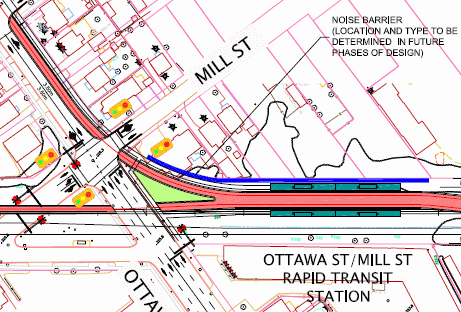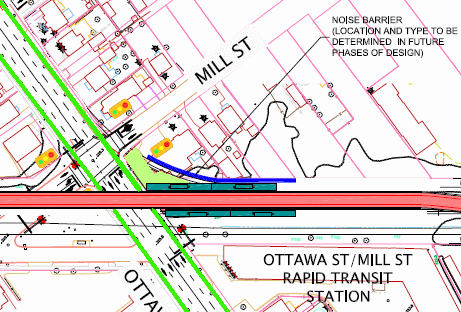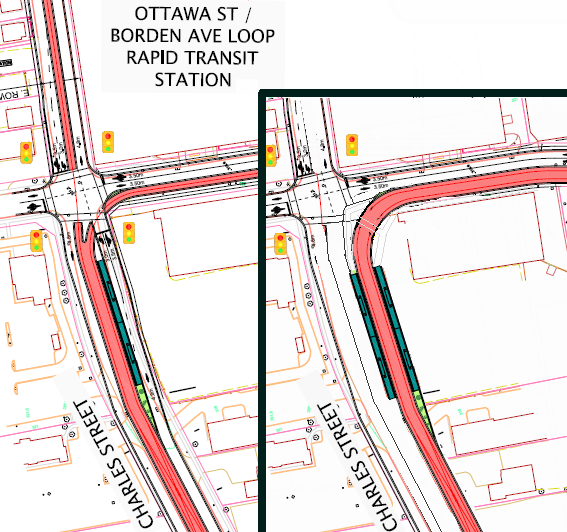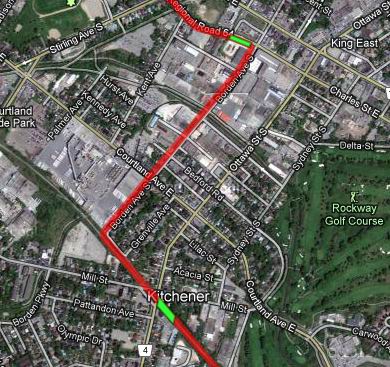Ottawa St, from King St to Mill St in central Kitchener, currently a two lane road flanked by driveways, single family homes, and some industry, is about to get a whole lot busier.
On the books for this 1 km stretch, according to the Region of Waterloo, are plans to:
- Widen the road from 2 lanes to 4 lanes. (link)
- Install dedicated biking infrastructure. (link and map)
- Run the northbound leg of the LRT line. (link)
In total, 1 LRT lane, 4 car lanes, and 2 bike lanes (if not better, segregated biking infrastructure).
That’s an awful lot to fit in the 20 metre right-of-way (pg 7). Comparing to road layouts planned for other sections of the LRT, it is apparent that this is a large amount to fit in the 30 metres between the front doors of the houses lining this stretch.
It is admirable to intend Ottawa St to serve all of these purposes, and there is no doubt that it is ripe for a rebuild and redesign, but there needs to be a holistic review of what we want to do with the corridor, and what we need to do with it, before we start digging.
If we blindly move forward with current plans for all of the road uses, it is likely that there will be great impact at great cost to the homes on Ottawa. At best, many homes will lose the majority of their lawns, and at worst, an entire side of the street will be expropriated, just as is happening on Weber St. Either way, this would be unnecessarily disruptive to an otherwise stable neighbourhood.
What can be done to mitigate this? Something needs to move, and that should be the LRT which would be rerouted to Borden Ave.
What needs to be on Ottawa?
Ottawa St is the only unbroken transportation cross-corridor through Kitchener east of Victoria St. It runs almost all the way from Trussler Rd to the Grand River. The most important considerations need to be made for services along this route. What needs to stay in the plan?
1) Traffic lanes: Maintaining the status quo of 2 lanes for the stretch will keep the existing bottleneck as Ottawa St narrows at Mill St and will cause greater congestion when GRT starts new express bus service along Ottawa. Redevelopment expected near the LRT stations in the King/Ottawa and Mill/Ottawa areas will increase traffic demands on the road network beyond the current capacity, and the Region will eventually have its hand forced to widen the road.
2) Bike Infrastructure: Whether bike lanes, cycle paths, or cycle tracks, if Ottawa is to become a bike friendly route across the centre of Kitchener, it cannot force cyclists into mixed traffic in its central section. There are no reasonable alternative routes in this area of Kitchener, as it is crossed by the Conestoga Expressway twice. If we hope to build a true cycling network, we should have a safe cross-town cycling corridor.
Moving the LRT
Borden Ave, however, has little of this transportation growth planned. It is expected to get a single lane of LRT added. However, there is space for more. The LRT is only constrained by the location of its stations, and while there is little room on Ottawa, there is plenty on Borden.
Borden runs through a predominantly industrial area, flanked on both sides by large factories and warehouses. Large setbacks leave a wide space to put in the LRT. The impending closure of the Schneider’s plant at Borden/Courtland, and the conversion of warehouse space to retail (Braun’s Cycles at Borden/Nyberg) are signs that the area is de-industralizing, and will be prime for redevelopment over the next 15 years. A consolidated station at Charles/Borden will encourage this redevelopment. Where there may be tight squeezes for LRT, the region can expropriate from these industrial lands and hasten this process, instead of expropriating from single family homes, degrading the quality of life of those living along Ottawa St.
Current plans have stations at Ottawa/Mill, Ottawa/Charles, and Borden/Charles. To run the LRT both ways on Borden, all that will change is moving the northbound Ottawa/Charles stop 150m up Charles St to Borden. Without the LRT turning from Ottawa onto the rail corridor, the Ottawa/Mill stop can now be located directly at Ottawa St, instead of being 50m south of the road (pg 4).
How does this affect transfers?
- 1) Transfers to and from Ottawa St South (at Mill St) will have a direct transfer, instead of a 50m walk south to the LRT platform.
- 2) Transfers to Ottawa St North will be exactly the same as the previous plan, a 150m walking transfer to Ottawa St.
- 3) Transfers from Ottawa St North now have the same 150m walking transfer up Charles. This is no further than transferring between busses at the current Charles St terminal. Those with extreme mobility issues will be able to transfer directly at Mill St.

Note 50m transfer, and complete expropriation required of corner property.
Mill/Ottawa After

Direct transfer, no property impacts, widened Ottawa St, green lanes indicating segregated cycletracks.
Charles/Borden

Current plan on left; conceptual side-running LRT on Charles, with both directions on Borden on right.
Stations no longer isolated in traffic. LRT does not interfere with cars.
Save Ottawa, Rebuild Borden
Ottawa St has plenty of change coming to enhance its cross-town transportation possibilities, for bus, bike and car. There is room for the LRT to leave this important corridor to cross-town purposes without hindering the LRT’s purpose. Consolidating the station to Charles/Borden will encourage redevelopment of industrial lands, improve mobility access to the LRT, lower construction impacts, and spare residential neighbourhoods from demolition, all at no extra cost.
Once the LRT is built, there will be no going back to fix this bottleneck. The Region needs to explore the alternatives now, and there is a strong case to move forward with this LRT realignment.


Thanks for posting this. When I saw the split alignment on Ottawa, I also wondered if the Region was making a serious mistake here. The only real downside of having both tracks go along Borden is a lengthier transfer between Ottawa buses and the LRT station at Borden and Charles but, as you note, that was already in the books for some of the connections, and a more direct transfer is available at Mill.
I hope the Region is paying attention, and I may follow this up with a letter to this effect.